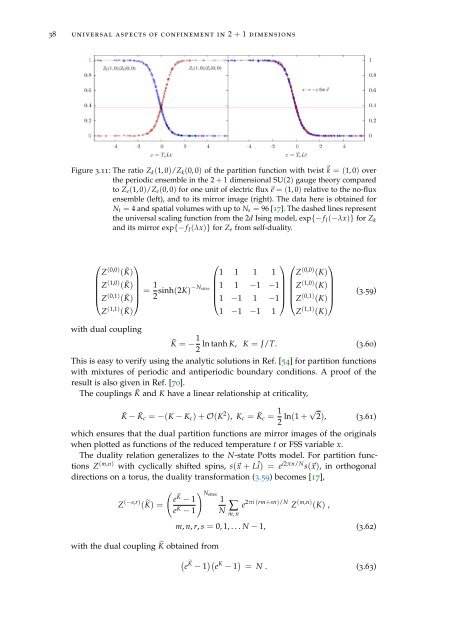Topology, symmetry, and phase transitions in lattice gauge ... - tuprints
Topology, symmetry, and phase transitions in lattice gauge ... - tuprints
Topology, symmetry, and phase transitions in lattice gauge ... - tuprints
You also want an ePaper? Increase the reach of your titles
YUMPU automatically turns print PDFs into web optimized ePapers that Google loves.
38 universal aspects of conf<strong>in</strong>ement <strong>in</strong> 2 + 1 dimensions<br />
Figure 3.11: The ratio Z k (1, 0)/Z k (0, 0) of the partition function with twist ⃗ k = (1, 0) over<br />
the periodic ensemble <strong>in</strong> the 2 + 1 dimensional SU(2) <strong>gauge</strong> theory compared<br />
to Z e (1, 0)/Z e (0, 0) for one unit of electric flux ⃗e = (1, 0) relative to the no-flux<br />
ensemble (left), <strong>and</strong> to its mirror image (right). The data here is obta<strong>in</strong>ed for<br />
N t = 4 <strong>and</strong> spatial volumes with up to N s = 96 [17]. The dashed l<strong>in</strong>es represent<br />
the universal scal<strong>in</strong>g function from the 2d Is<strong>in</strong>g model, exp{− f I (−λx)} for Z k<br />
<strong>and</strong> its mirror exp{− f I (λx)} for Z e from self-duality.<br />
⎛ ⎞<br />
⎛<br />
⎞ ⎛ ⎞<br />
Z (0,0) ( ˜K)<br />
1 1 1 1 Z (0,0) (K)<br />
Z (1,0) ( ˜K)<br />
⎜<br />
⎝Z (0,1) ⎟<br />
( ˜K)<br />
= 1 ⎠ 2 s<strong>in</strong>h(2K)−N sites<br />
1 1 −1 −1<br />
Z (1,0) (K)<br />
⎜<br />
⎟ ⎜<br />
⎝1 −1 1 −1⎠<br />
⎝Z (0,1) ⎟<br />
(K) ⎠<br />
Z (1,1) ( ˜K)<br />
1 −1 −1 1 Z (1,1) (K)<br />
(3.59)<br />
with dual coupl<strong>in</strong>g<br />
˜K = − 1 ln tanh K, K = J/T. (3.60)<br />
2<br />
This is easy to verify us<strong>in</strong>g the analytic solutions <strong>in</strong> Ref. [54] for partition functions<br />
with mixtures of periodic <strong>and</strong> antiperiodic boundary conditions. A proof of the<br />
result is also given <strong>in</strong> Ref. [70].<br />
The coupl<strong>in</strong>gs ˜K <strong>and</strong> K have a l<strong>in</strong>ear relationship at criticality,<br />
˜K − ˜K c = −(K − K c ) + O(K 2 ), K c = ˜K c = 1 2 ln(1 + √ 2), (3.61)<br />
which ensures that the dual partition functions are mirror images of the orig<strong>in</strong>als<br />
when plotted as functions of the reduced temperature t or FSS variable x.<br />
The duality relation generalizes to the N-state Potts model. For partition functions<br />
Z (m,n) with cyclically shifted sp<strong>in</strong>s, s(⃗x + Lî) = e i2πn/N s(⃗x), <strong>in</strong> orthogonal<br />
directions on a torus, the duality transformation (3.59) becomes [17],<br />
Z (−s,r) ( ˜K) =<br />
with the dual coupl<strong>in</strong>g ˜K obta<strong>in</strong>ed from<br />
(<br />
e ˜K Nsites<br />
− 1 1<br />
e K − 1)<br />
N ∑ e 2πi (rm+sn)/N Z (m,n) (K) ,<br />
m, n<br />
m, n, r, s = 0, 1, . . . N − 1, (3.62)<br />
(<br />
e ˜K − 1 )( e K − 1 ) = N . (3.63)
















